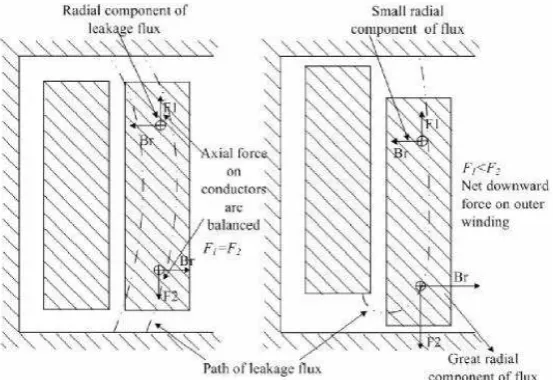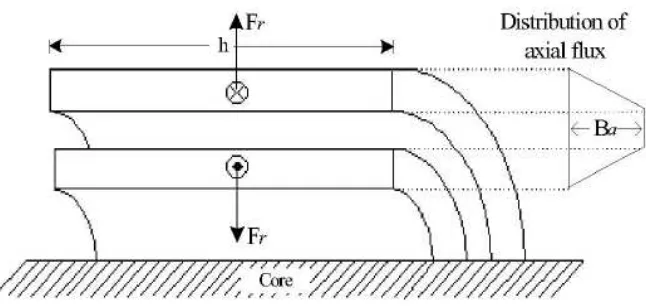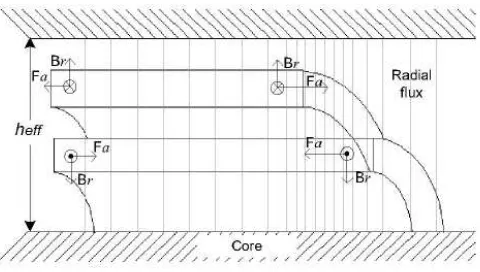UNIVERSITI TEKNIKAL MALAYSIA MELAKA
Investigation of Short circuit forces on individual turn of
transformer winding- FEM simulation
This report submitted in accordance with requirement of the Universiti Teknikal Malaysia Melaka (UTeM) for the Bachelor Degree of Engineering Technology
(Industrial Power) (Hons.)
by
LIM BOON KIAT
B071210251
910104-04-5485
UNIVERSITI TEKNIKAL MALAYSIA
MELAKA
BORANG PENGESAHAN STATUS LAPORAN PROJEK SARJANA MUDA
TAJUK: Investigation of Short circuit forces on individual turn of transformer winding- FEM simulation
SESI PENGAJIAN: 2014/15 Semester 1
Saya LIM BOON KIAT
mengaku membenarkan Laporan PSM ini disimpan di Perpustakaan Universiti Teknikal Malaysia Melaka (UTeM) dengan syarat-syarat kegunaan seperti berikut:
1. Laporan PSM adalah hak milik Universiti Teknikal Malaysia Melaka dan penulis. 2. Perpustakaan Universiti Teknikal Malaysia Melaka dibenarkan membuat salinan
untuk tujuan pengajian sahaja dengan izin penulis.
3. Perpustakaan dibenarkan membuat salinan laporan PSM ini sebagai bahan pertukaran antara institusi pengajian tinggi.
4. **Sila tandakan ( )
SULIT
TERHAD
TIDAK TERHAD
(Mengandungi maklumat yang berdarjah keselamatan atau kepentingan Malaysia sebagaimana yang termaktub dalam AKTA RAHSIA RASMI 1972)
(Mengandungi maklumat TERHAD yang telah ditentukan oleh organisasi/badan di mana penyelidikan dijalankan)
_____________________________
Alamat Tetap:
KM 1169 Taman Jaya Kelemak,
78000 Alor Gajah,
Melaka.
Disahkan oleh:
_____________________________
Cop Rasmi:
i
DECLARATION
I hereby, declared this report entitled “Investigation of short-circuit forces on individual turn of transformer winding- FEM simulation” is the results of my own research except as cited in references
Signature :……….
Name : … LIM BOON KIAT …
ii
APPROVAL
This report is submitted to the Faculty of Engineering Technology of UTeM as a partial fulfillment of the requirements for the degree of Bachelor of Engineering Technology (Industrial Power) (Hons.). The member of the supervisory is as follow:
iii
ABSTRACT
iv
ABSTRAK
v
DEDICATIONS
vi
ACKNOWLEDGMENTS
First of all, I would like to express my greatest gratitude and thanks to Universiti Teknikal Malaysia Melaka (UTeM) for the opportunity to completely the PSM and their kind effort to provide me with all the facilities and technical expertise to make this report successful.
Beside that I also would like to give my greatest thank to our project supervisor, En Zulkifli Bin Ibrahim and En Syahrul Hisham Bin Mohamad @ Abd. Rahman in their guide and opinions for my PSM. Thank also to my friends who help me with given many ideas and willing to share their information and knowledge with me.
vii
2.2 Short-circuits current effects the transformer winding ... 4
2.3 Mechanical forces effect on transformer winding during short-circuit ... 5
viii
2.6 Displacement between winding ... 7
2.7 Calculation of the electromagnetic forces ... 8
2.7.1 Calculation of radial electromagnetic forces for concentric windings... 9
2.7.2 Calculation of axial electromagnetic forces for concentric windings ... 10
2.8 Finite Element Method for Designing and Analysis of the transformer ... 11
CHAPTER 3 ... 13
3.0 Introduction ... 13
3.1 Project development flow ... 13
3.1.1 Flow chart of the research ... 14
3.2 Literature Review ... 15
3.3 Software installation ... 15
3.4 Finite Element Method ... 16
3.5 Finite Element Modelling ... 17
3.6 Magnetic Force ... 18
3.7 Step in simulate magnetic force in 2D ANSYS Maxwell ... 19
CHAPTER 4 ... 24
4.0 Introduction ... 24
4.1 Construction and dimension of core ... 25
4.2 Construction and dimension of winding ... 26
4.3 Geometrical Characteristics of transformer... 27
4.4 Simulation Result from ANSYS Maxwell 2D ... 30
ix
4.6 Flux line plot ... 32
4.7 B vector plot ... 33
4.8 Surface force density ... 34
4.9 Analytical Calculation Result ... 35
4.10 Comparison result between two methods ... 36
CHAPTER 5 ... 38
5.0 Introduction ... 38
5.1 Summary of Research ... 38
5.2 Achievement of Research Objectives ... 39
5.3 Significance of Research ... 39
5.4 Problems Faced During Research ... 40
5.5 Suggestion for Future Work ... 40
x
Figure 2.1 : Type of transformer ... 4
Figure 2.2 : Mechanical forces on transformer winding. (Jurcik, J., Gutten, M., & Korenciak, D. 2011) ... 5
Figure 2.3: Typical effects of electromechanical stress on the transformer windings caused by radial forces. (Rosentino Jr, A. J. P et al, 2011). ... 6
Figure 2.4 : Typical effects of electromechanical stress on the transformer windings caused by axial forces. (Rosentino Jr, A. J. P et al, 2011). ... 7
Figure 2.5 : Axial forces on the winding (Ana C. De Azevedoet al ,2006) ... 8
Figure 2.6: Cross section of a transformer concentric windings ... 9
Figure 2.7 : Cross section of a transformer, radial field density and axial force ... 10
Figure 3.1 : Flow chart of research ... 14
Figure 3.2 : ANSYS Maxwell ... 15
Figure 3.3 : Different methods of electromagnetic analysis ... 16
Figure 3.4 : Steps to be taken when using Finite Element Software ... 17
Figure 3.5 : Procedure to model 3 phase transformer ... 18
Figure 3.6 : Sketched winding / command window ... 19
Figure 3.7 : Material selection ... 20
Figure 3.8 : Step to assign current in winding ... 20
Figure 3.9 : Steps to assign force parameter ... 21
Figure 3.10 : Create region and ballon ... 22
Figure 3.11 : Validation check ... 22
Figure 3.12 : Solution data ... 23
Figure 4.1: Three phase transformer and their winding ... 24
Figure 4.2 : Core dimension ... 25
Figure 4.3 : Core dimension ... 26
Figure 4.4 : Winding dimension... 26
Figure 4.5 : Winding Hight ... 27
Figure 4.6 : Geometrical Characteristics of transformer ... 27
Figure 4.7 : 90MVA of 132/33KV transformer ... 28
Figure 4.8 : Dimension of winding in simulation ... 29
Figure 4.9 : Winding sketched in ANSYSS MAXWELL 2D ... 29
Figure 4.10 : Radial and Axial Force Simulation Result ... 30
Figure 4.11 : Magnetic B field plot ... 31
Figure 4.12 : Flux line ... 32
Figure 4.13 : B vector plot ... 33
xi
LIST OF TABLE
Table 1: Radial force analytical calculation ... 35
Table 2: Axial force analytical calculation ... 36
Table 3: Radial force comparison ... 36
1
CHAPTER 1
INTRODUCTION
1.0 Introduction
Transformers are electrical devices that transform or change the voltage levels between two circuits. It plays an important role in the power system, as it help convert power to appropriate levels so that other components can be safely used. These transformers are often in operation for a long time and only stop working during power interruptions or maintenance.
Nowadays at this fast developing country, the demand of electric power is rising sharply and it adding more and more generating capacity and interconnection to the system. Hence, it will cause major losses when service failure and increase of undelivered energy cost. In order to achieve trouble-free power transmission, the failure caused by short-circuits in the transformer had to be considered.
1.1 Problem statement
In short-circuit condition, the forces occurred in winding of transformers have to be determined. This is because electromagnetic forces occurring on the transformer winding during short circuit condition depend on the material selection and careful structural design. Therefore by accurately predict these forces, it aids in choosing structural design or arrangement at the winding to mitigate the impact of this forces in order to avoid in-service failures and reduce the undelivered energy cost and replacement cost.
2
provides a significant degree of accuracy which is very useful to analyse electromagnetic forces.
1.2 Objectives
The goal that to be achieving in this research are:
1. To demonstrate the behaviour of an individual turn during short circuit by the use of Finite Element Method (FEM)
2. To compare the analytical and numerical (FEM) calculation in normal and short circuit conditions
3. To determine the effect of this forces on transformer
1.3 Scope
This research has the following scope:
3
CHAPTER 2
LITERATURE REVIEW
2.0 Introduction
There are many literature about short-circuits on transformer winding. For better understanding of short-circuit, many research articles of other work and also primary and secondary source had been read and study. This chapter was going to describe the theory and concept of the relevance information about my research topic.
2.1 Core construction
4
Figure 2.1 : Type of transformer
Source: http://www.electricaleasy.com/2014/03/electrical-transformer-basic.html (1/3/2014)
2.2 Short-circuits current effects the transformer winding
Jurcik, J., Gutten, M., & Korenciak, D. (2011) states that short circuit and overvoltage (transient actions) affect the power transformer and it need to be specialise analyzed. This is because they had serious importance in design and operation on transformer. Short-circuit in operation are mainly produced by different line faults such as the mechanical damage of insulation, electric insulation, electric insulation breakdown on over voltage, wrong operation and so on.
Short-circuit can be identified as serious poor condition of transformer due to neglect because the high current produced will cause badly rising temperature that can damage transformer insulation. The high electro-magnetic forces is the most dangerous one as it may occur due to great destruction of transformer so the transformer winding and its coils must be structural and stable in order to tolerate high mechanical forces without damage .
5
The main cause of the pattern of forces that affect the winding is the magnetic field that influence on current flowing conductors. In transformer, it is the field of stray flux. When in the state of normal operation, the currents in transformer do not exceed rating value so the forces affecting on winding was usually in low level. But when in short-circuits conditions, the currents rating values will be double and this forces is dangerous to the windings.
Forces that affecting the winding usually divided into two groups which is radial forces (cross) and axial forces (longitude). These two components was considered independently in calculating strength, as they usually produce stresses of different kinds and can trigger different and independent modes of collapse.
Figure 2.2 : Mechanical forces on transformer winding. (Jurcik, J., Gutten, M., & Korenciak, D. 2011)
2.4 Radial forces in windings
6
inner winding is more frequent than in the outer winding and it may occur due to two different ways.
One of the occurrences radial deformations is the forced buckling, it occurs when the inner winding is supported by spacers located in the axial direction to the conductors. These occur when the stress value exceeds the material elastic limit. While the other is known by free buckling. For this, the conductor is deformed in one or more radial points of the coil winding.
Figure 2.3: Typical effects of electromechanical stress on the transformer windings caused by radial forces. (Rosentino Jr, A. J. P et al, 2011).
2.5 Axial forces in windings
7
and generally this arrangement was used in large transformers.
Figure 2.4 : Typical effects of electromechanical stress on the transformer windings caused by axial forces. (Rosentino Jr, A. J. P et al, 2011).
2.6 Displacement between winding
Any asymmetry between windings can produce large axial forces and produce serious hazard for the transformer solidarity by Ana C.de Azevedo et al (2006). In the situation where the inner and outer windings are symmetrical and balanced built up, the leakage flux is symmetrically distributed and generating opposite axial forces at the ends of the winding, thus generate zero resultant force.
8
the full balancing of the winding troublesome and produces a hazard resultant force on the winding.
a)Windings magnetically balanced b) windings displaced axially
Figure 2.5 : Axial forces on the winding (Ana C. De Azevedoet al ,2006)
2.7 Calculation of the electromagnetic forces
Under short circuit conditions, the leakage flux will greatly increased cause forces occurring on the windings. The resultant force is proportional to the squared current, independently of the type of arrangement of the transformer windings.
The maximum electromagnetic forces are produced by three-phase short circuits, so it is common to design transformers to withstand the maximum peak of this short circuit current. This condition takes into account the transformer connected to an infinite busbar. The equation to determine the worst condition of short circuit current (Icc) for a three phase transformer is
9 MVA is the transformer rating power [MVA];
V is the transformer rated voltage [V];
Z is the per unit impedance of the transformer.
2.7.1 Calculation of radial electromagnetic forces for concentric windings
The analytical calculation of radial force components in the transformer with concentric windings can be calculated easily and accurately. The axial field density (Ba) has its maximum in the region between the windings (leakage flux) and it is zero in the internal and external surfaces of the inner and outer windings respectively. Thus the force in per unit of length throughout the length of the coils remains almost constant and can be precise calculated. Below was the cross section for the transformer with two concentric windings.
Figure 2.6: Cross section of a transformer concentric windings
10
By neglecting the flux spreading out at the end of the windings, the radial force (Fr) due to interaction between the instantaneous-turns in each winding (ni) and the leakage field density can calculated as below.
Where : i is the currents in transformer winding,
n is the number of turn,
h is the length of the winding and
Dm is the mean diameter of the winding.
2.7.2 Calculation of axial electromagnetic forces for concentric windings
Below was the layout of the radial field and the axial forces in an arrangement with asymmetrical windings. The asymmetry was due to the height of the outer winding is shorter than the inner windings causes a huge density of radial flux in the region where the unbalanced of ampere-turns occurs.
Figure 2.7 : Cross section of a transformer, radial field density and axial force
11
calculate simply as axial field calculation. Residual Ampere turns method was a well-accepted approach used in calculate radial force, it is based on the principle that any arrangement of concentric windings can be split into two groups having balanced ampere turn. One produces the axial field and the other the radial field.
To calculate the axial compression force, the following parameters is necessary to identified.
a. The effective length of path of the radial flux, heff. This differs for each arrangement of tapings.
b. The average radial flux density (Br) , considering the average diameter of the transformer
c. The average value of ampere turns which is equal to (1/2)a(ni), where a is the length of tap section (or group of short-circuited turns) expressed as a fraction of the total length of the winding.
The axial force (Fa) for a transformer with tap section in one end of the external winding is determined as:
2.8 Finite Element Method for Designing and Analysis of the transformer


